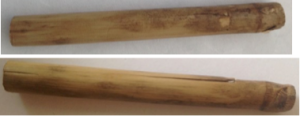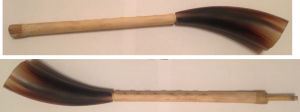Organology of Anglo-Saxon Wind Instruments
First year PhD student Lucy-Anne Taylor reports on her Masters Research:
Over the last year I have been studying Anglo-Saxon wind instruments, notably one found at Hungate in York for my music masters. In some ways this was a continuation from my undergraduate dissertation, completed in archaeology, on Anglo-Saxon wind instruments. I am now moving this work through into a PhD in Music and Archaeology.
 While there has been some work on the Anglo-Saxon music, this is limited leaving a number of gaps. One of the biggest problems encountered with looking at the Hungate instrument was the lack of sources or evidence for what the instrument was. As can be seen from the picture very little is left and at first it is extremely unclear what it may have been. The instrument itself, probably originally in one piece is now in two with an unknown amount missing in the middle. There is some idea of what instruments were around during the Anglo-Saxon period and out of these it quickly became apparent that only category which it really fitted into was pipes. However, this in itself is a broad topic, ranging from flutes to reed. The shape of the upper tenon meant it was unlikely to have been a flute. Therefore I was left with just reed instruments, including both single and double and those with added sections such as a bag or bladder. In order to further understand what it may have been I had to look at any possible evidence for reed instrument in existence at the time-an area on which some of the experts have been known to say that while they ask the questions they cannot provide answers.
While there has been some work on the Anglo-Saxon music, this is limited leaving a number of gaps. One of the biggest problems encountered with looking at the Hungate instrument was the lack of sources or evidence for what the instrument was. As can be seen from the picture very little is left and at first it is extremely unclear what it may have been. The instrument itself, probably originally in one piece is now in two with an unknown amount missing in the middle. There is some idea of what instruments were around during the Anglo-Saxon period and out of these it quickly became apparent that only category which it really fitted into was pipes. However, this in itself is a broad topic, ranging from flutes to reed. The shape of the upper tenon meant it was unlikely to have been a flute. Therefore I was left with just reed instruments, including both single and double and those with added sections such as a bag or bladder. In order to further understand what it may have been I had to look at any possible evidence for reed instrument in existence at the time-an area on which some of the experts have been known to say that while they ask the questions they cannot provide answers.
In the end, through the limited pictorial and literal sources, as well as the history of the instruments, I concluded that there is evidence for bagpipes, bladder pipes, pibgorns and some kind of double reed pipe being around, or at least known of, during the Anglo-Saxon period.
When it came to deciding which instrument the Hungate instrument was likely to have been out of these experimentation with reeds helped. It was discovered that double reeds would probably have been very difficult to make out of the plants around at the time. Arundo donax will not grow in this country and there is not any real evidence for importing it into the country during this period. However, a plant related to Arundo donax, called Arundo phragmites, was around in this country at the time and quite possibly used for reeds. Indeed it is still used to make reeds for pibgorns today. This was experimented on and while double reeds did not work (although someone with more experience may have succeeded) it was found single reeds could be made easily and produced a sound!
used for reeds. Indeed it is still used to make reeds for pibgorns today. This was experimented on and while double reeds did not work (although someone with more experience may have succeeded) it was found single reeds could be made easily and produced a sound!
With the realisation that this was quite possible what the reeds were it then seemed possible that the instrument was originally some kind of pibgorn style instrument given the use of a reed traditionally used for that instrument. In addition there was no plate with which to tie on a bladder or bag and no other section of a bagpipe/bladder pipe style instrument was found close to the other remains of the instrument. Indeed, going through the finds books showed nothing of that sort was amongst the finds.
The way the Hungate instrument had broken was in keeping with Elder. Elder has fast growing stems with a pithy centre that can easily be hollowed out. The main body of the instrument was therefore recreated from one of these stems and then carved on the outside (see picture below). Elder was often associated with magic during the Anglo-Saxon period, like music, making it possible this was a reason the wood was chosen and possibly giving the instrument a magical, mystical properties.

When the main body of the instrument had been recreated and reed added to it, a horn was added (cut down from its original size). This was tried as both a reed cap and bell (see picture below). With this it was possible to test distance over which the instrument may once have been heard.
 Through the making of the reeds and assessing evidence on the instrument, such as lack of a plate, it was concluded the instrument was of a pibgorn style with a built in bell to make it different to the Welsh instrument. The recreated instrument could have been made from tools around at the time. Experimentations with playing the instrument showed not only tunes could be played but also the sound carried further than the average human voice. This opened up the possibility of the instrument being used for purposes such as signalling and locating people as well as for entertainment. Below the original instrument with the recreated body of the instrument can be seen (with a reed in the tenon end).
Through the making of the reeds and assessing evidence on the instrument, such as lack of a plate, it was concluded the instrument was of a pibgorn style with a built in bell to make it different to the Welsh instrument. The recreated instrument could have been made from tools around at the time. Experimentations with playing the instrument showed not only tunes could be played but also the sound carried further than the average human voice. This opened up the possibility of the instrument being used for purposes such as signalling and locating people as well as for entertainment. Below the original instrument with the recreated body of the instrument can be seen (with a reed in the tenon end).
I am now moving forward with more research on this topic through a PhD. One of the instruments I am currently looking into is the organ, and instrument for which the limited amount of descriptions and lack of archaeological evidence and images means very little is known and understood about how the instrument may have worked and been constructed at the time. The one at Winchester was supposed to have been of an immense scale and heard from over a mile away! It is hoped my research will help us understand not only the construction and workings of it but also allow for a recreation of at least a section of an Anglo-Saxon organ to be completed.
We are pleased that Lucy-Anne was recently awarded the 2017 Terence Pamplin Award for Organology, which will help her pursue her PhD studies at Southampton. Read the full story.

